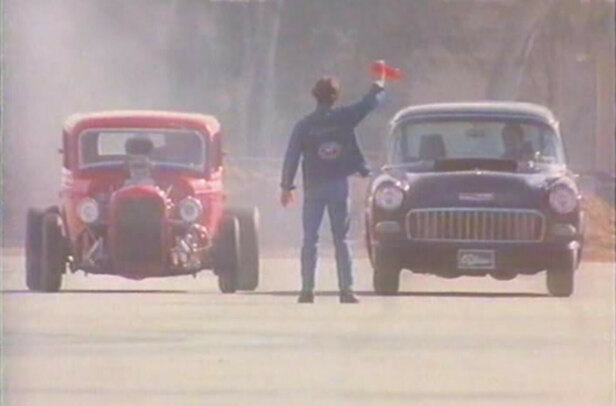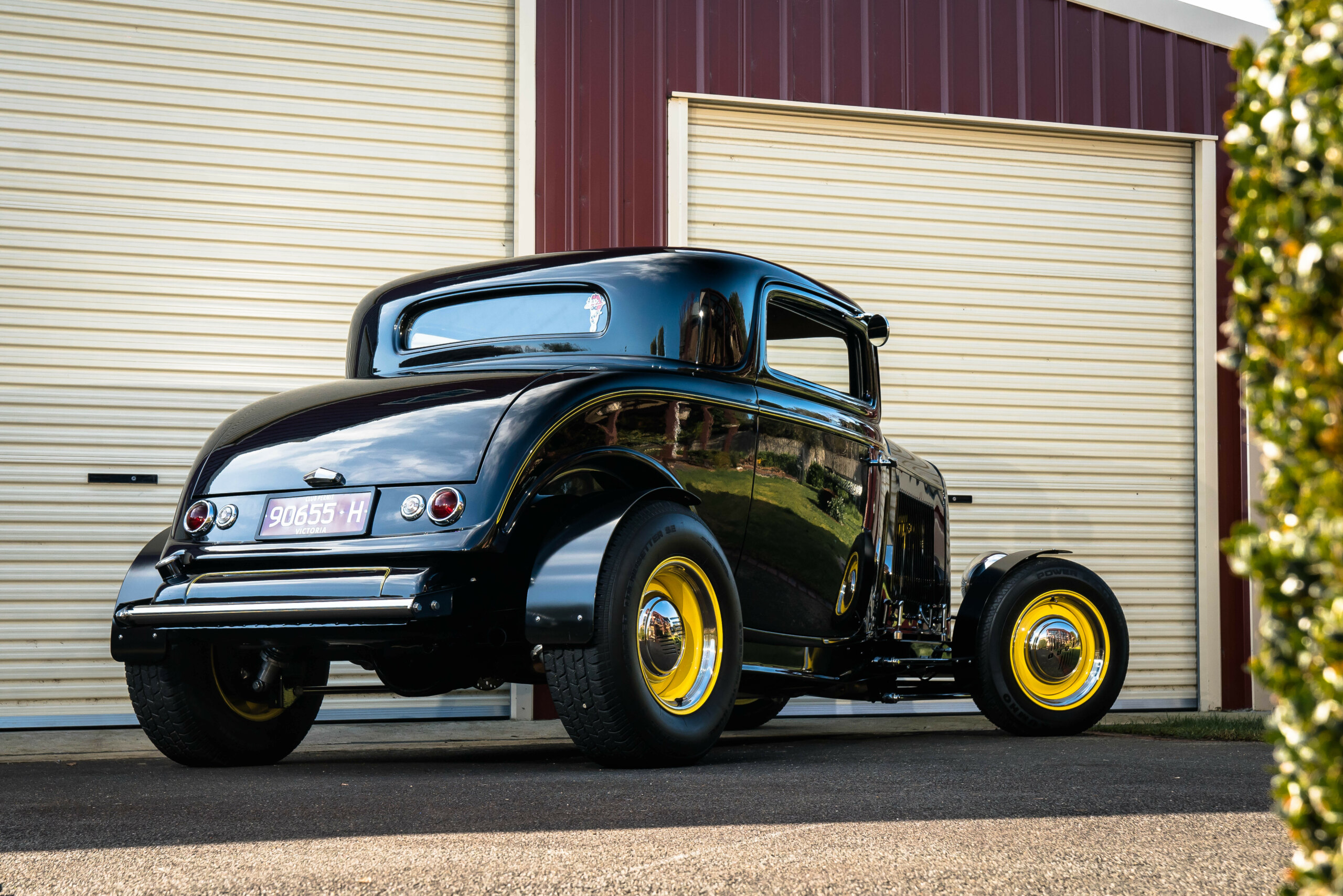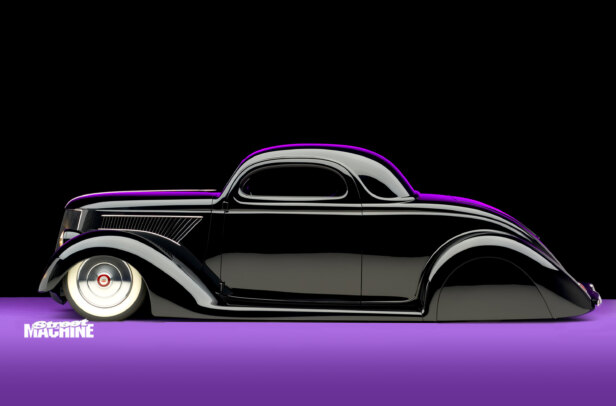Immortalised on the sleeve of the Beach Boys 1963 album Little Deuce Coupe, this ’32 Ford must be the most famous hot rod ever. The song might claim “a flathead mill” while the real thing ran a blown Olds but to millions this three-window is the Little Deuce Coupe. The story of the real car features a starry-eyed kid, drag racing and some of the most famous rod builders of all time.
As published in the December 2010 issue of Street Machine
Clarence ‘Chili’ Catallo grew up in Detroit, Michigan, not five miles from the giant Ford Rouge plant. In 1956, aged 15, he had hot rod fever and bought the channelled ’32, minus engine, for $75. It was to be his only hot rod. Too young to drive, he had a dream and worked in his family’s general store while saving up for a donk. He bought a junkyard Olds V8 with a McCulloch blower and, with his mate Bob Nugent, installed it in the coupe.
Still underage, he used a fake licence and started racing at the Baltimore Drag Strip. The coupe was quick for its time, running a best of 12.9@112mph.
However, by 1959 Clarence was taking the first steps from track to show.
He had the coupe in a constant state of flux, like most rods at the time, but he wanted more and took the car to Detroit’s leading customisers, Mike and Larry Alexander at Alexander Brothers Rod & Custom Shop.
The first job was to shorten the doors and Z the frame to enhance the coupe look. It was at this point that the famous side strakes were added, covering the space below the doors left exposed from the channel job.
A-Brothers created the new rear end with a rolled pan made from sections of Studebaker front pans, along with a large grille opening for the nerf bars and frenched tail-lights.
Mike and Larry also created the famous vertical quad-light nose. With a stamped mesh aluminium grille and hand-formed horizontal ribs, the grille shell flipped forward for engine access.
Inside, Ray Kulakowski whipped up headstone buckets in pearl white Naugahyde, blue piping and buttons, plus a two-sided buttoned and tufted roof insert in matching white Naugahyde.
Clarence added a colour-matched ’59 Lincoln Continental steering wheel, while the A-Brothers created plastic flipper hubcaps from ’57 Plymouth caps. They rounded off their work with a coat of deep blue paint and silver scallops.
By now the coupe was way ahead of the pack. It wowed the crowds at the ’59 Detroit Autorama — and Clarence still wasn’t 18 years old!
He dubbed the car ‘Silver Sapphire’ after the colour of his high school prom date’s dress but that also marked the end of school. His folks wanted him to go to college and be the first member of the family to graduate from university, while Clarence wanted to build rods. Eventually he decided on Long Beach Community College in California — where the cool cars were!
So at 18 he hauled Silver Sapphire west, to the Barris Kustom Shop in Lynwood, Los Angeles. He needed somewhere to store the coupe and George Barris obliged by parking it in the showroom. George liked the kid and soon put him to work.
“When Clarence turned up, he started asking how much for this and that, and how could he pay for it?” George says. “I loved what the A-Brothers had done but all Clarence could think about was doing more. He came in so often that I gave him a broom to sweep up the shop.
Within a month he was sanding, taping and handing tools to people. I put him on a time card for work on these projects, to work off some of his future customising.”
In the summer of 1960, the crew at Barris Kustoms lopped three inches out of the roof, leaving it 15 inches lower than stock, buttoned up the bodywork, cut the glass to shape, modified the window moulds and reworked the body for new paint, applied by Junior Conway at the Barris shop.
They stuck with the A-Brothers design but tweaked the scallops and ran brilliant Pearl Oriental Blue duco with pearl white scallops. As a final highlight, Clarence added a set of double-sided whitewall tyres up front and whitewall slicks on the rear.
By 1961 he was finally satisfied. He’d had the Olds updated with a 6/71 GMC blower and a tri-pack of 97 Strombergs by Ed Roth, plus lashings of chrome details.
Meanwhile, Hot Rod editor Bob Greene had seen Silver Sapphire at shows and arranged to have it shot as the colour cover feature for the July ’61 issue, with a four-page spread inside. It seemed the ultimate thrill for the 21-year-old Clarence, yet more was to come.
When Capitol records needed a hot rod for a new Beach Boys album called Little Deuce Coupe, they called George Barris. He knew that Clarence’s coupe was perfect and that Hot Rod had some great photos, so he put them together and the rest is history. The cover shot turned Silver Sapphire into Little Deuce Coupe overnight and, yep, that’s Clarence tinkering with the engine!
Not long after, Clarence finished at Long Beach College and sold the coupe to a Pennsylvania hot rod club for $5500. They showed it for two years, then sold it in 1963 to Ray Woloszak. Ray still owned it when it appeared at the Detroit Autorama in 1997, though he’d replaced the Oldsmobile with a Mopar 440 and put a lot of work into making the coupe a reliable street car.
Amazingly, Clarence hadn’t seen the coupe in 30-odd years but his son, Curt, convinced him that he should get it back and restore it to its Hot Rod cover glory. The car wasn’t for sale at the time but later that year it was bought by Autorama promoter Bob Larivee Jr, who sold it on to Clarence.
Sadly, Clarence passed away in 1998, just after the restoration began, but Curt enlisted help from all over Detroit to get the project finished. The restoration was handled by Jon Moss, the former head of GM Special Projects who now runs Wheel to Wheel in Troy, Michigan. Curt discovered that trimmer Ray Kulakowski was still in business so he did the interior a second time!
Even Oldsmobile helped with the engine and transmission restoration, while the A-Brothers made sure it was done to 60s standards.
In recognition of its huge cultural status, the coupe was invited to the 2001 Pebble Beach Concours d’Elegance. Then, as a feature attraction at the 50th Detroit Autorama, it cemented its position at the top of the hot rod totem pole.
So there it is, the amazing story of how a kid from Detroit lived his hot rod dream.




Comments